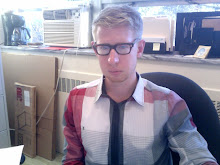So, in the vein of many of our class discussions, I've been thinking about collecting. What would intentionally queer collections look like, be composed of and displayed? Why not a queer museum? This blog is a contemporary supplement to the previous post in which I posture queerness on the phenomenon of pre-modern cabinets of curiosity.
Recently, I had an excellent bar conversation with fellow grads Akiko Jackson and Keith Mendak about why there are not widely-recognized queer museums. If black history museums and other minority/ethnic group museums persist, why not LGBTQ museums? Keith thinks this is because African-American museums are easier to mount as a counterpoint to the Western canon of museums, and that race is skin or surface, and much easier for our culture to deal with. As a puritanically-based, sexually-repressed culture, creating a queer museum would be taboo, as it delves deeper than the surface, to reveal our psychological and sexual layers of identity.
In googling "queer museum," one of the first hits I got was the introduction to a book on issues for museum practices:
"One response to the marginalization of lesbian, gay, bisexual, and transgender (LGBT) perspectives in museums has been to make a bid for increased inclusivity. Such a gesture potentially foregrounds universalist notions of LGBT identity and desire. Queer theory, however, understands gender and sexuality as relational constructs, subject to historical and cultural variation. Against this backdrop, what would it mean to theorize the queer museum? This article engages with this question on a number of levels: it draws attention to the distorting effects that certain models drawn from contemporary identity politics generate in museums, especially in exhibitions with a historical focus, and it examines the role played by concepts of "public opinion" on representations of gender and sexuality in museum spaces. It also considers the challenge that queerness presents to the idea of the museum as a normalizing, meaning-making entity, and asks how these concerns are already being addressed in museum practice." from "Theorizing the Queer Museum." in Museums & Social Issues, Volume 3, Number 1. Left Coast Press, Inc. Spring 2008.
Well, it appears some thinkers have been down this queer road before... So queer museums could be in unconventional places, such as that of the Leather Archives & Museum in Chicago, thus celebrating queerness at its source. Or staged in community-oriented spaces, such as the Queer Cultural Center, in San Francisco, a city that is itself a virtual museum of queer culture. The queer museum could be composed of work by queer artists, straight artists making work about queer issues, or artworks that pertain to or uphold queer theory. Such a museum would also perform as a venue for collecting artifacts of sex, sexuality, gender and identity.
Now that the United States has a person of color as president for the first time in our history, I cannot help but wonder how our institutions of minority celebration will change in context. Certainly, there are scholars raising questions as to the validity of such institutions in a modern era that is perhaps “post-minority” or "post-identity," as exemplified by the election of Barack Obama, a mixed-race person. I personally hope this new era of American politics and presidency will strengthen minority institutions. WASP male culture still pervades our everyday lives, whether it is acknowledged in academia or otherwise. As I have much hope for human rights policy changes under a new and mostly Democratic government, it would be an awesome time for the emergence of a bonafide queer museum in the USA. It's crazy to think that someday there may be a national GLBTQ History Museum on the Mall in Washington, D.C. And if there is, I want to be the art curator!
